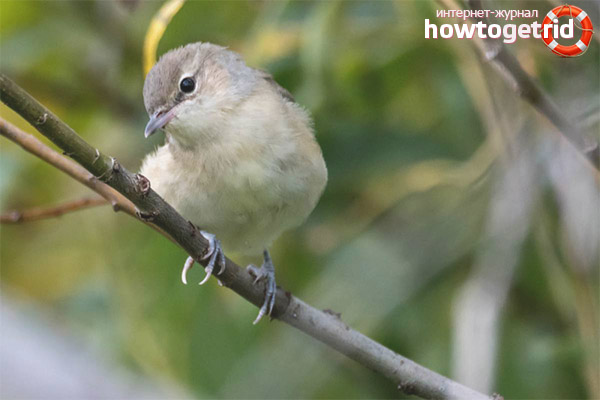The content of the article
About 20 species of birds belong to the genus Slavkov, which have a lot in common. They are small, agile and beautifully sung. The plumage is predominantly gray and brown in the species. Small areas of the body are painted white and black, and some species have pinkish and red colors. The body length of most Slavs is about 15 cm. Weigh about 20 g.
What feeds on
In the summer, eat insects. The diet includes flies, mosquitoes, caterpillars. In the cold season, they feed on berries and seeds.
Habitat in nature
They live practically throughout Eurasia, as well as in northern parts of Africa.
Most members of the genus are migratory birds. They live, as a rule, on the edge of a forest, in a city park.
Types of slaves
- Atlas He lives in the north of Africa, as well as the southern latitudes of Europe. The body length is about 13 cm. It nests at high altitude - 1200-2400 m. It spends the winter in Morocco.
- African desert. The dimensions are small - the size and weight of birds is 12 cm and 10 g. The belly is white and the back is brown. The color of the beak and legs of these African inhabitants is yellow. As the name implies, live in Africa. Does not apply to migrants.
- Belousaya. Males have gray plumage on their backs, and on their belly they have pink feathers. White stripes are visible on the tail. Females on the back are gray-brown. The belly is white. For the winter flies to the Red Sea. You can meet in the Caucasus, as well as in Turkey.
- Mountain. It weighs about 16 g. Lives in the mountains on the territory of Afghanistan, Pakistan, Kazakhstan. For the winter flies to India. Length - 13-15 cm.
- Yemen sinitsya. He lives in Saudi Arabia, Yemen.
- Spectacled. On external signs resembles a gray slavka. Distributed in Europe. The body length is about 12-14 cm. It weighs less than 10 g. Its wings are brown. Gray plumage on head, brown on back, and pinkish on abdomen.
- Singing. The belly is white. He lives in Asia and in the southern forests of Europe. The head of the species is decorated with a black “cap”.
- Pinching. It lives in the Asian savannas. Can live at altitudes up to 2000 m.
- Provençal. The length of this representative of the genus is 11-15 cm. From above, the plumage on the body is gray, and from the bottom - red. He lives in the southern regions of Europe.
- Deserted He lives in Africa and Asia. Yellowish plumage above, white-reddish below. Bill is yellow.
- Sadovaya. He lives in Europe and Siberia. Plumage monophonic. It has a gray-brown color with a faint green tint. Lower body is white.
- Sardinian. Lives in the southern part of Europe. It has a large beak. On the back of the plumage is painted gray, and on the stomach is painted in a brick shade. The legs are red.
- Gray. Gray-brown plumage on the back, and ashen on the head and sides. The belly is pinkish. He lives in Eurasia and northern Africa. Sizes like a sparrow.
- Ruppel The color is gray. The wings are black. These birds live in Turkey, Greece. In the color of the tail there is white and black.
- Zavirushka. He lives in the center of Europe. It weighs about 14 g. Brown plumage.
- Mediterranean. He lives in Italy and Spain. The plumage on the upper part in males of this species is dark gray, the lower one is lighter. The head is painted black. Females have a gray head. In this case, the back of the Mediterranean female is brown.
- Subalpine. He lives in the Mediterranean.The length of these birds is 12 cm. The back is gray in color, the belly is lighter. On the chest there is a strip of white.
- Blackhead Habitat - North Africa, Europe. Weigh about 21 g. The color is brownish gray. The males have a black “cap”, while the females have a reddish color.
- Hawk Lives hawk in Europe. The length of the body of representatives of the species is 18 cm. It weighs up to 30 g. From above the plumage is gray with a slightly greenish tint. On the bird's belly, the coloring resembles a hawk. Hence the name.
Sex differences

Sexual deformity is present in some species. It is expressed weakly. Gray-brown color allows you to mask in the bushes.
Content
Quite well take root at home. By the nature of peace.
Keep warm in a spacious cage. In it there should be a perch and a tank where Slavka could bathe.
You can feed the grain mixture, as well as berries, fruits. During the nesting period it is necessary to give animal food in the form of insects.
Breeding
When kept in pairs can breed. You need to put or plant in the cage vegetation, which they will use as material for the nest. Eggs in clutch 5-8, which incubate parents alternately.
Interesting Facts
- Lead a secretive lifestyle, but in the city park you can hear the crows singing.
- They migrate at night, the polar star is a reference point for them.
- In nature, can live to 10 years. And in captivity - up to 12.
Singing
Both males and females sing loudly. Features of singing depend on the type. For some, it is rhythmic, for others - more gentle. They copy the singing of other birds, and while keeping a house they can copy a person.
Video: garden flick (Sylvia borin)











To send